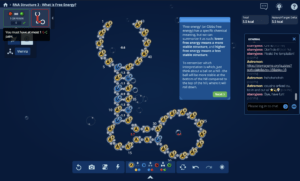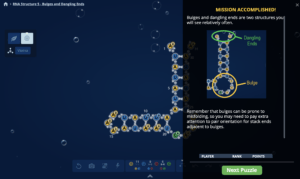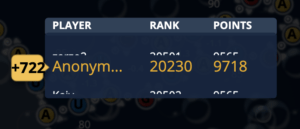EteRNA is a puzzle game initially produced by Jeehyung Lee, and now being developed by researchers at Stanford and Cornell University. The game has players shape together RNA molecules by changing particular base pairs, which affect how the molecule forms. The puzzle is considered completed when the sequence of base pairs match together to form the desired RNA molecule shape, alongside whatever additional restrictions may be imposed on the player. EteRNA exhibits fun mainly through challenge – even beginner tutorial puzzles are fairly difficult and there are a number of complex interactions and mechanics to take into account. The broader EteRNA community also exhibits fun through fellowship and expression – players can cooperate together to solve problems that are shared amongst the community (there’s even a chat function!), and players can show off their creativity/artistry by designing puzzles or shapes for the community. I personally also found fun through sensation – the game gives you wonderful audio and visual feedback for every action you take, and I honestly found myself enjoying just mindlessly swapping pairs of molecules back and forth while brainstorming just to hear the sounds.
Applying MDAO to Eterna:
Mechanics: EteRNA’s mechanics are primarily bound to the real-life binding properties of base pairs – certain base pairs will match with each other, certain pairs of bases will have stronger connection force than others, and the presence of certain bases at certain locations may influence the connections of pairs (known as ‘boosting’). Other properties can also be viewed by the player, such as the free energy at each loop (which impacts stability), and how the molecule will fold given the players current configuration. These mechanics are presented in a somewhat abstracted, gamified form, and while the real-life context for each is explained, it is not a requirement to be able to solve the puzzles.

Dynamics: One dynamic that occurs as a result of EteRNA’s complex mechanics is that for most puzzles the solution is never immediately obvious or linear, which promotes a different way of thinking about puzzles. Rather than a sort of start to end process like a maze, players are incentivized to apply general principles and strategies that might fit to whatever problem they are trying to solve. The game points out common structures that appear often, and how the player should approach recreating those structures, and even provides a sort of general outline to how to approach most puzzles.


These mechanics also create a trial-and-error approach to problem solving alongside these general guidelines, as often simply swapping the positions of a base pair can end up being a difference maker. Especially since it is almost impossible to consider every single interaction simultaneously, players are incentivized to focus on subsections of the problem and test possible combinations incrementally. The complexity also encourages some of the more social aspects of EteRNA, such as asking other players for help through the chat system.
Aesthetics: This complexity creates an immense sense of accomplishment upon a puzzle’s completion. As opposed to a more submission-type of puzzle game (e.g, Candy Crush), because solving the puzzle is such an active process on the part of the player, it drives a feeling of improvement and achievement. The game plays into this feeling with a host of rewards and positive feedback for puzzle and incremental completions – creating pairs of bases that align with the target structure will flash “Great pairings!” on the screen alongside an audio cue, completing a puzzle comes with a climatic audio visual effect, alongside achievement badges and a point/ranking system that shows your overall score relative to other EteRNA players.


Outcomes: I think that the intended outcome is to try to get average people with less of a science-heavy background to become interested in RNA and eventually even contribute to solving RNA-based problems that would otherwise be computationally difficult to solve, or as the website puts it, “find novel solutions, invent new medicines, and unravel the secrets of RNA”. These concepts are certainly things that would be hard to get the average person without a bio background to become interested in, and so all the elements of the game seem to specifically catered to easing players into this complex informational environment – the gamified progression of knowledge and skills, the focus on achievement and accomplishment, and the social components all help to nudge players in the right direction. Given that EteRNA players have actually contributed to a number of scientific papers and research, with many of those players having essentially no research background whatsoever, I think it’s safe to say that the game has succeeded tremendously at its goal.

